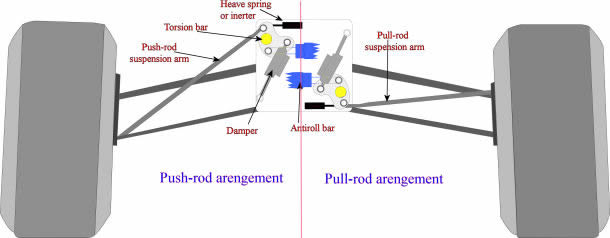Push-rod - pull-rod
 |
| Pull-rod suspension |
 |
| Push-rod suspension |
Push-rod or pull-rod, the difference as the name suggests is the whether the rod push up to the rocker or pull down to the rocker.
Pull rods were first brought to Formula 1 by Gordon Murray with Brabham in the 70s but now all formula one teams make use of the push rods, as pull rods are quite hard to implement in a high nosed car. The advantages of a pull rod lie in the possibility to make the nose lower, assemble most suspension parts lower to the ground and thus lowering the height of the center of gravity.
Pull rod set up has a strut from the outer end of the upper wishbones that runs diagonally to the lower edge of the chassis and "pulls" a rocker to operate the spring\damper.
A push rod is the opposite; the strut runs from the lower wish bone to the upper edge of the chassis.
Choice between the two is geometry and CoG (Centre of gravity). Also a pull rod will flex in droop (wheel going down) and push rod will flex with the wheel in bump (wheel going up) hence F1 push or pull rods are large carbon molding to withstand the flexing from the high wheel loads.
Most F1 cars now use push rods. The high nose makes it almost impossible to locate a rocker low enough in the chassis and still have the right geometry. Minardi and Arrows used pull rods with low noses to lower the centre of gravity. These two teams are a last two to use this concept.
Pull-rod suspension has been ignored because of the installation problems with high nose cars. The critical geometry in spring\damper layouts is the installation angle of the push\pull-rod In the picture of Minardi PS1 below, the pull-rod has an angle of around 35-degrees which is fairly steep. Notice how high on chassis is the the point where it meets the upper wishbones, on some cars these are now almost as low as the floor of the monocoque. Then the keel below the square section of the monocoque reaches down to pick up the lower wishbone, the space created below the nose is what allows the front wing to be so efficient as there is little to obstruct the wake forming. The keel is made to be as slender as possible to improve flow under the nose. Should the nose be made lower the aerodynamics would be crippled.
When pull-rod suspension were adopted with a good installation angle, the rocker would need to be located near the keel (upsetting the aerodynamics) or upper pick up point of the pull-rod would need to be located somewhere above the tire, clearly a upper wishbone mounted pull-rod with a rocker inside the monocoque would never be able to work efficiently due to the poor installation angle.
Access problems used to be a common problem with pull-rod suspensions: The removal of the dampers and rockers being hindered by their low location inside the monocoque.
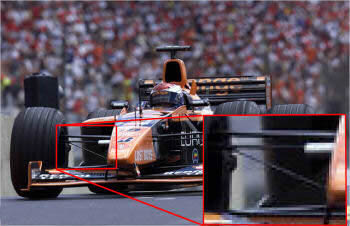 |
Jos Verstappen in Arrows20, Year is 2000 and designer of this car is aerodynamicist Eghbal Hamidi |
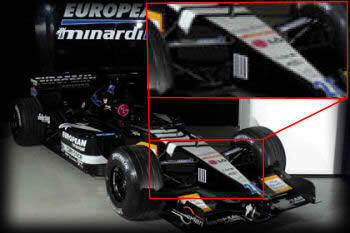 |
European Minardi PS01 Designed by Gustav Brunner and Gabriele Tredozi 2001. |
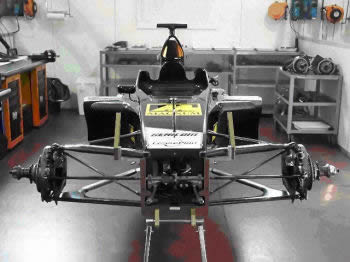 |
In the typical torsion bar push rod set up described below the torsion bars pass through the centre of the rockers and fix to the front of the chassis. The Rocker pivots on the torsion bar. The push rod push the rocker and twists the torsion bar to provide the spring in the suspension, the rocker then compresses the damper and operates the antiroll bar if the car is in roll.
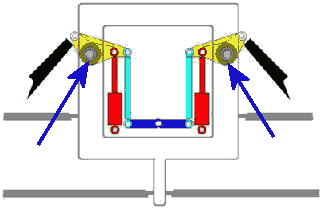 |
Black - Push rod |
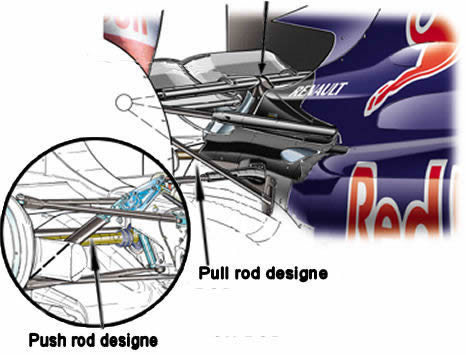
During preseason testing for year 2009 RedBull Racing with Adrian Newey like technical director and chief designer, brings pull-rod rear suspension back to Formula One for the first time after 10 years. The last pull rod dates from 2000 with the low nosed Arrows A20 which featured it.
With the diffuser moving rearwards under the revised 2009 regulations, the pull-rod layout allows for cleaner aero packaging for rear suspension area. See circle for more common push rod set-up witch normally occupy more space under the engine cover, preventing designers to make clean airflow toward rear wing because suspension rockers and dampers are positioned on the top of the gearbox.
Because of Red Bull's choice to create very low sidepods at the back end, a push rod did not make much sense as the suspension components would prevent a clean design. The pull-rod version has allowed the designers to put more components close to the car's floor, lowering its centre of gravity. The pull-rod suspension is lighter and, along with a gearbox that is now 15cm lower, helps to improve handling. The top wishbone is a single piece and is attached very high at the rear of the car (see upper arrow), actually they connect above the car's bodywork, in the most ideal position, forming a wing-like section that works together with the lower section of the rear wing. With some imagination, if you would turn the car upside down, the rear suspension is effectively connected at inverted single keel. The keel is here supporting both upper wishbones.
This solution was clearly valid as the RB5 was the only car with a single deck diffuser to challenge the Brawn cars. However it was exactly the reason why the Brawn was so fast, that undid Newey’s low-line rear end philosophy. As the Brawn had a Double Deck diffuser (DDD this solution found a loophole in the rules that created a secondary diffuser tunnel starting much further forwards and rising much higher). Suddenly in the race to also exploit this loophole, Newey found out that his Pull-rod set up was occupying the exact same space that the DDD needed for the upper tunnels. Newey chose not to design a completely new rear end, and compromised the design of his DDD within the constraints of his pull rod suspension.
For 2010 the car was designed with a DDD in mind, Newey was able to repackage the pull rod set up for even larger tunnels. He said that the choice of Pull-rod for 2010 was still not the obvious way to go, but the team decided to stick with a proven pull rod rear end, rather than have to design an all new rear end. Other teams also looked at the feasibility of a Pull-rod rear end, However no other teams followed this design path, with the exception of the Toro Rosso team who used the RB5 design in 2009 and simply revised it for their 2010 car.
Also note the very low and rearward positioning of the exhausts (lover picture, right arrow), which exit just under the front arm of the rear wishbone, and the lack of a central pillar to the rear wing, which is instead mounted via the wing's two large endplates, which attach directly to the diffuser. This concept will evolve next year (2010) to very successful blown diffuser, critical part in driver and constructor championship win by Red bull Racing.
For 2011 the DDD is banned, with revised technical regulations outlawing the openings beneath the car to allow air to flow into the upper diffuser deck. Thus again we will see teams consider the pull rod layout for better airflow to the rear wing. During pre season 2011 presentations of the new cars, all but Ferrari and Sauber are going with pull rod.
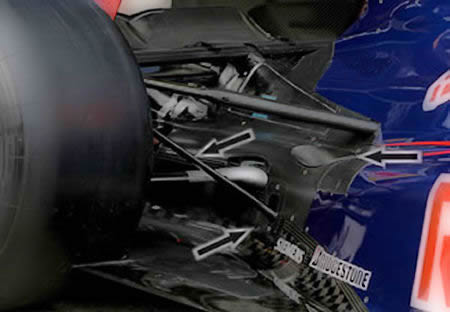
Which is better – Push or Pull rod system
In terms of their effectiveness as controlling the wheels, both are equal. In terms of effect on aerodynamics each has its merits depending on the prevailing rules and trends. However both have different benefits and demands on the chassis. Pull-rod clearly provides a lower CofG, although access can be an issue. Sometime, in case of rear pull-rod suspension, floor have to be removed. In Red Bulls case they place the 3rd spring and inerter horizontally across the front of the gearbox. This means one sits above and the other below the shaft connecting the engine to the clutch. These can only be accessed when the gearbox is removed and are subject to a lot of heat.
One difference is in the load passed through the wishbones. As per Newton’s third law, the rod has to react to the force of the springs. This passes back from the rocker to the mount on the wishbone. In push-rods case, this reaction force is in the opposite direction to the force fed from the wheel into the chassis, the two offset each other. With Pull-rod the force from the rod and the wheel act in the same direction, this doubles the load in the upper wishbone and resultantly in the mounting the on the gearbox. This can be accounted for design and weight of the final wishbone design. However, push rod also has its structural problem. The push rod when the suspension in in bump (wheel rising) the rod is in compression and would tend to bow outwards. The push rod was the first suspension component to have carbon fibre cladding for reinforcement, again design and weight is needed to offset this load. Suspension experts point out that pull-rod suffers similar compression bending when the suspension is in droop (wheels falling), but droop is considered less critical in wheel control, than bump. There’s no one answer to which is best, you look at your design requirements and pick which solution works, best. Next year the best car is not necessarily going to be the one with Pull-rod rear suspension.
During season 2011, all teams followed RedBull Racing rear suspension pull-rod solution except Ferrari and Sauber (because Sauber was using Ferrari gearboxes). And then 2012 Ferrari surprised everybody with extreme solutions on their new challenger. They changed their rear suspension and are gone for pull-rod with the F2012. Last year we saw the Ferrari had a very complex push-rod setup around the rear suspension rockers and placing all this stuff lower down around the clutch and engine drive shaft, will be a tough to package. The new hybrid carbon and titanium gearbox casing now has to accommodate a different rear suspension system, with the switch to pull rod spring\damper operation and the raised upper wishbone. Because of revised gearbox, the rear top wishbone has been repositioned and new pull-rod arrangement neatly packaged.
Only a Ferrari deserves mention of front suspension during the 2012 preseason cars launch and testing, as they have revived an old direction with its pull-rod front suspension layout. Every other car for well over 11 years has had push-rod front suspension, but Ferrari reused an old idea, last time raced with Gabriele Tredozi and Gustav Brunner-designed European Minardi PS1, raced by certain Fernando Alonso and Tarso Marques. Both then and now one of the drivers at the wheel is Alonso.
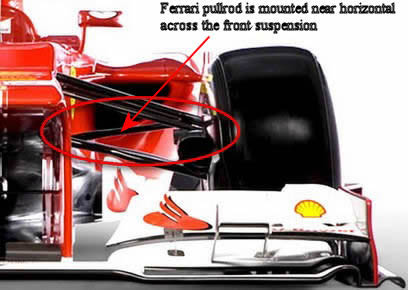
According to Pat Fry, Ferrari technical director, this set up is a little lighter and has a slightly lower Centre of Gravity. Only these gains will not pay for trouble to include this system on the car, so must be some important aero benefit in that. In theory pull-rod itself can be thinner than a push rod, but because the pull rod is mounted to the top wishbone, and its extreme angle, greater loads are applied to the upper wishbone, which has to be stronger - and heavier - than it would have been.
Meanwhile, there is a much bigger disadvantage to using pull-rod suspension in terms of the limitations it creates in being able to tune the car's handling.
If you move the push-rod mounting point backwards or forwards of the fulcrum of the top and bottom wishbone, you can transfer load across the car when the driver is steering and effectively "lighten" the front wheel. That means the car can be tuned to work in both high and low-speed corners. It allows you to make the car softer and more compliant in low-speed corners without softening the suspension - thereby keeping the high mechanical stiffness you need in the car for high-speed corners.
Ferrari's decision to design pull-rod suspension limits their ability to tune the F2012's handling. Ferrari's pull-rod is connected to the wishbone, not the upright, so that tuning facility is not available in the same way for Ferrari. You can still do some of it with the king-pin and castor angles, but anything you do that helps you in one area of the track will hurt you in another. That compromise doesn't exist with push-rods. So getting the ideal balance in handling characteristics for both low- and high-speed corners is tougher with pull-rod front suspension than with push-rod. Ferrari have effectively taken a tool out of their tool bag.
Only real gain is that the pull-rod is mounted near horizontal across the front suspension. This places it in line with the upwash air stream from the front wing. Just as with the wishbones, its profile can be subtly altered within the rules to help control the wake from the wing and improve the airflow over the rear of the car. Despite appearances the pull-rod is as effective in moving the rocker for a given wheel travel as a push-rod is. The important factor is the angle between the rod and the wishbone on which is connected, rather than the rods angle to the chassis.
After four years of pull-rod suspension, new 2016 challenger changed back to push-rod suspension, a step forward compared to last few years and previous models.
If you want my opinion, there is a reason why pull-rod suspension geometry was out of Formula 1 for so many years.
History is repeating itself.

